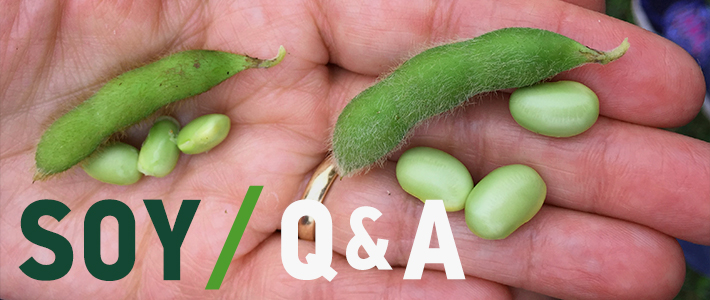
Consumers are more health-conscious than ever before, but with an overload of nutrition “facts,” there are many misconceptions. In a few words, I will try to address some common questions about soy.
Does eating soy increase your risk for breast cancer?
Eating soy does not increase the risk of breast cancer. Exposure to Isoflavones (the phytochemical/antioxidant in soy) does not adversely affect breast tissue cells. The American Institute for Cancer Research stated that women who have been diagnosed with breast cancer can safely consume soyfoods.1-5
Is soy a good source of protein?
Soyfoods are delicious and versatile with many options such as edamame, soy milk, tofu, tempeh, soy butter, soy nuts, to name a few. Soy is the only plant protein that carries the FDA’s heart health claim6 and it provides all nine essential amino acids. Soybeans are equivalent to animal products in terms of protein quality.7
Can consuming soy help protect against chronic disease?
Recent studies demonstrated that soy has the potential to lower your risk of heart disease, may lower blood pressure, and may improve bone health and cognitive function.8-9 Soy also contains a number of phytosterols, which may have the ability to reduce LDL cholesterol.10
Is eating soy healthy/does it have any health benefits?
Soy protein is rich in folate, potassium, and fiber that can help manage hunger and appetite.11 The omega-6 polyunsaturated fat in soybean oil may reduce the risk of heart disease and lower bad cholesterol when replacing saturated fats, according to the American Heart Association.12
Why should I use soy as an ingredient in my meals?
Soyfoods are available in just about any grocery store, making it a readily available ingredient to explore different flavor and texture combinations in your meals. Not only does it pair well with other plant-based foods, but it can also be easily paired with beef, fish, or poultry. I love combining lean ground beef with chopped mushrooms and soy curls. The soy curls texture and the mushrooms nutty-meaty flavors make for a delicious addition to your burgers or meatballs. Also, adding soy and vegetables to your dish is a great way to save money or reduce your meal budget.
Soyfoods can be part of your healthy diet! For more myth-busting facts or any other questions on soy, visit: www.soyconnection.com/healthprofessionals/mythbusting.
I only endorse brands and products I love! All opinions expressed are my own. I received compensation to write this post in partnership with Soy Connection.
References
- World Cancer Research Fund/American Institute for Cancer Research. Diet, Nutrition, Physical Activity, and Cancer: a Global Perspective. Continuous Update Project Expert Report 2018. Available at dietandcancerreport.org.
- Lampe JW. Emerging research on equol and cancer. J Nutr. 2010;140(7):1369S-1372S.Nagata C. Factors to consider in the association between soy isoflavone intake and breast cancer risk. J Epidemiol. 2010;20(2):83-89.
- Chen M, Rao Y, Zheng Y, et al. Association between soy isoflavone intake and breast cancer risk for pre- and post-menopausal women: a meta-analysis of epidemiological studies. PLoS One. 2014;9(2):e89288.
- Nechuta SJ, Caan BJ, Chen WY, et al. Soy food intake after diagnosis of breast cancer and survival: an in-depth analysis of combined evidence from cohort studies of US and Chinese women. Am J Clin Nutr. 2012;96(1):123-132.
- Zhang YF, Kang HB, Li BL, Zhang RM. Positive effects of soy isoflavone food on survival of breast cancer patients in China. Asian Pac J Cancer Prev. 2012;13(2):479-482.
- U.S. Food and Drug Administration. “Authorized Health Claims That Meet the Significant Scientific Agreement Standard.” https://www.fda.gov/food/food-labeling-nutrition/authorized-health-claims-meet-significant-scientific-agreement-ssa-standard. January 12, 2018.
- Protein Digestibility-Corrected Amino Acid Scores (PDCAAS) for Soy Protein Isolates and Concentrate: Criteria for Evaluation. Journal of Agriculture and Food Chemistry.
- U.S. Food and Drug Administration. “Soybean Oil and Reduced Risk of Coronary Heart Disease.” https://www.fda.gov/media/106649/download. July 31, 2017. Supportive but not conclusive scientific evidence suggests that eating about 1½ tablespoons (20.5 grams) daily of soybean oil, which contains unsaturated fat, may reduce the risk of coronary heart disease. To achieve this possible benefit, soybean oil is to replace saturated fat and not increase the total number of calories you eat in a day. One serving of this product contains 14 grams of soybean oil.
- “Omega-3 fatty acids.” https://www.genetherapy.me/inflammation/omega-3-fatty-acids-university-of-maryland-medical-center.php. University of Maryland Medical Center. 2015.
- Ostlund RE, Jr. Phytosterols in human nutrition. Annu Rev Nutr. 2002;22:533-549.
- USDA National Nutrient Database for Standard Reference Release. https://ndb.nal.usda.gov/ndb/foods/show/16108.
- Harris WS, Mozaffarian D, Rimm E, et al. “Omega-6 fatty acids and risk for cardiovascular disease: a science advisory from the American Heart Association Nutrition Subcommittee of the Council on Nutrition, Physical Activity, and Metabolism; Council on Cardiovascular Nursing; and Council on Epidemiology and Prevention.” Circulation 2009;119:902-7.

